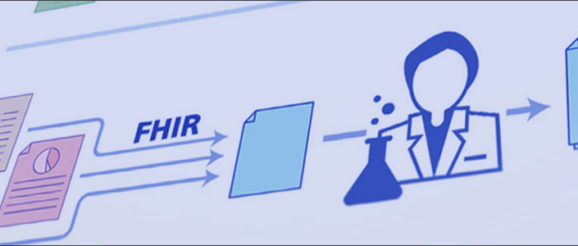Accelerating Innovation in Science – NLM Musings from the Mezzanine

Fast.
Interoperability.
Resource.
Word about FHIR—pronounced “fire”—is spreading quickly across the National Institutes of Health (NIH) and scientific community, and for good reason.
The FHIR format
is a global industry standard for exchanging health care data between institutions.
Most electronic health records systems in
hospitals and physicians’ offices already use FHIR to send and receive critical
information for patient care and to support billing for patient services. With
proper oversight and human subjects’ protection, clinical research and
scientific advancement can benefit from FHIR. Data is becoming increasingly
important for biomedical research, including predictive phenotyping and the
conduct of clinical trials.
NIH is taking steps to promote the use of FHIR in its funded clinical
research to facilitate data access and promote interoperability of research
data while protecting patient privacy and ensuring consistency with informed
consent.
This afternoon, Clem McDonald, MD, Chief Health Data Standards Officer at the National Library of Medicine (NLM) at NIH, announced two notices issued today by NIH regarding FHIR at the Blue Button 2.0 Developer Conference held at the White House Eisenhower Executive Office Building in Washington, DC.
The Guide Notice on FHIR encourages NIH-funded investigators to explore the use of FHIR to capture, integrate, and exchange clinical data for research purposes and to enhance capabilities to share research data. The Notice aims to make all NIH-funded researchers aware of the emerging ability to extract data from electronic health records using FHIR and encourage them to use FHIR-compatible formats when sharing data, consistent with privacy restrictions and informed consent. Following this notice, NIH will soon solicit input from the scientific community and other stakeholders about the tools that might be needed to support use of FHIR in biomedical research, as well as implementation challenges and opportunities they foresee in using FHIR.
To complement the research component, NIH also posted a Notice of Special Interest to inform the small business innovation research and small business technology transfer communities of NIH’s interest in supporting proposals that use FHIR in the development of health information technology products and services. NIH is interested in the implementation of the FHIR standard in health IT applications, such as the integration of patient- and population-level data from electronic health records systems, access to and management of electronic health information, the development of clinical decision support systems, the enhancement of recruitment into clinical trials, and improving privacy and security for electronic health information.
These efforts will help implement the NIH Strategic Plan for Data
Science and build on activities already under way in individual Institutes
and Centers within NIH. The NLM’s
new strategic plan positions the NLM as a platform for data powered health,
which will lead to the development of new analytics and novel visualization
approaches to accelerate discovery-from-data.
As we promote the use of FHIR by
our funded researchers and potential developers, institutes and centers across
NIH—including the NLM, the National Human Genome Research Institute, and the
National Center for Advancing Translational Sciences—are taking the lead in creating
and using FHIR APIs in various research domains. Ongoing and emerging efforts
aim to improve the retrieval of genomic and phenotypic data from the NIH
database of genotypes and phenotypes, integrate data from genetic test results
into electronic medical records, and prototype the infrastructure needed to
query clinical data from partner organizations. Based on what we learn from our
engagement with the scientific community, we anticipate supporting development
of other tools and resources that can help scientists make better use of FHIR to
enhance their research endeavors.
NIH is in a key position to contribute to the development of
the research capabilities of FHIR—and we come ready to combine technology,
scientific research, and data to make break-through discoveries to improve
health.
We’re interested in your experiences and guidance. Come
along with us, and let us know how NIH can help you and your researchers make
the best use of FHIR.
